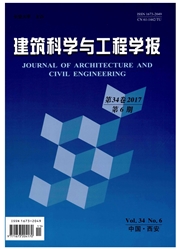

 中文摘要:
中文摘要:
以成都某复杂体型超高层建筑为研究对象,在大气边界层风洞中对其进行了单体建筑刚性模型测压试验,对模型表面风压的分布规律进行了讨论;利用随机振动理论在频域内计算了基础等效静力风荷载和结构顶部加速度响应,并将风荷载试验结果与中、日两国最新规范的计算结果进行对比分析。结果表明:复杂体型高层建筑表面风压的分布规律与常规截面高层建筑基本保持一致,但是受到建筑体型的影响,个别立面的风压分布会出现与中国规范规定值完全相反的结论;同时,在局部区域会出现比规范值偏大的结果,由风洞试验结果计算得到的顺风向基底剪力和弯矩均大于中、日两国规范的计算结果,且日本规范的计算结果要大于中国规范的计算结果。所得结论可为类似工程提供参考。
 英文摘要:
英文摘要:
Based on the wind tunnel test of the rigid model of a complex shape high-rise building in Chengdu in the atmospheric boundary layer ,the surface wind pressure distribution laws of model were discussed .The equivalent static wind loads and wind-induced acceleration responses of top structure were calculated based on the wind tunnel results and compared with those estimated from Chinese and Japanese building design codes by using random vibration theory calculations of the model in the frequency domain . The results show that surface wind pressure distribution characteristics of complex shape high-rise building are coincided with those of conventional cross-section high-rise building .But the individual facade and normative pressure distribution results will appear the opposite conclusions owing to building size impacting .Meanwhile ,in the local area ,test results will be larger than the standard value results .The downwind base shear and bending moment calculated by the wind tunnel test results are greater than that by Chinese and Japanese codes ,and calculation results of Japanese code are bigger than those of Chinese code . The conclusions obtained in the paper can provide reference for structural design of similar pro-jects .
 同期刊论文项目
同期刊论文项目
 同项目期刊论文
同项目期刊论文
 期刊信息
期刊信息
